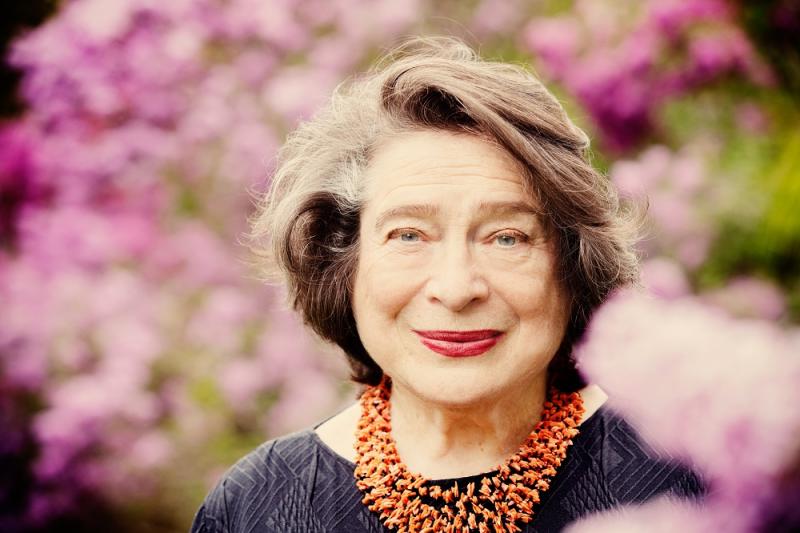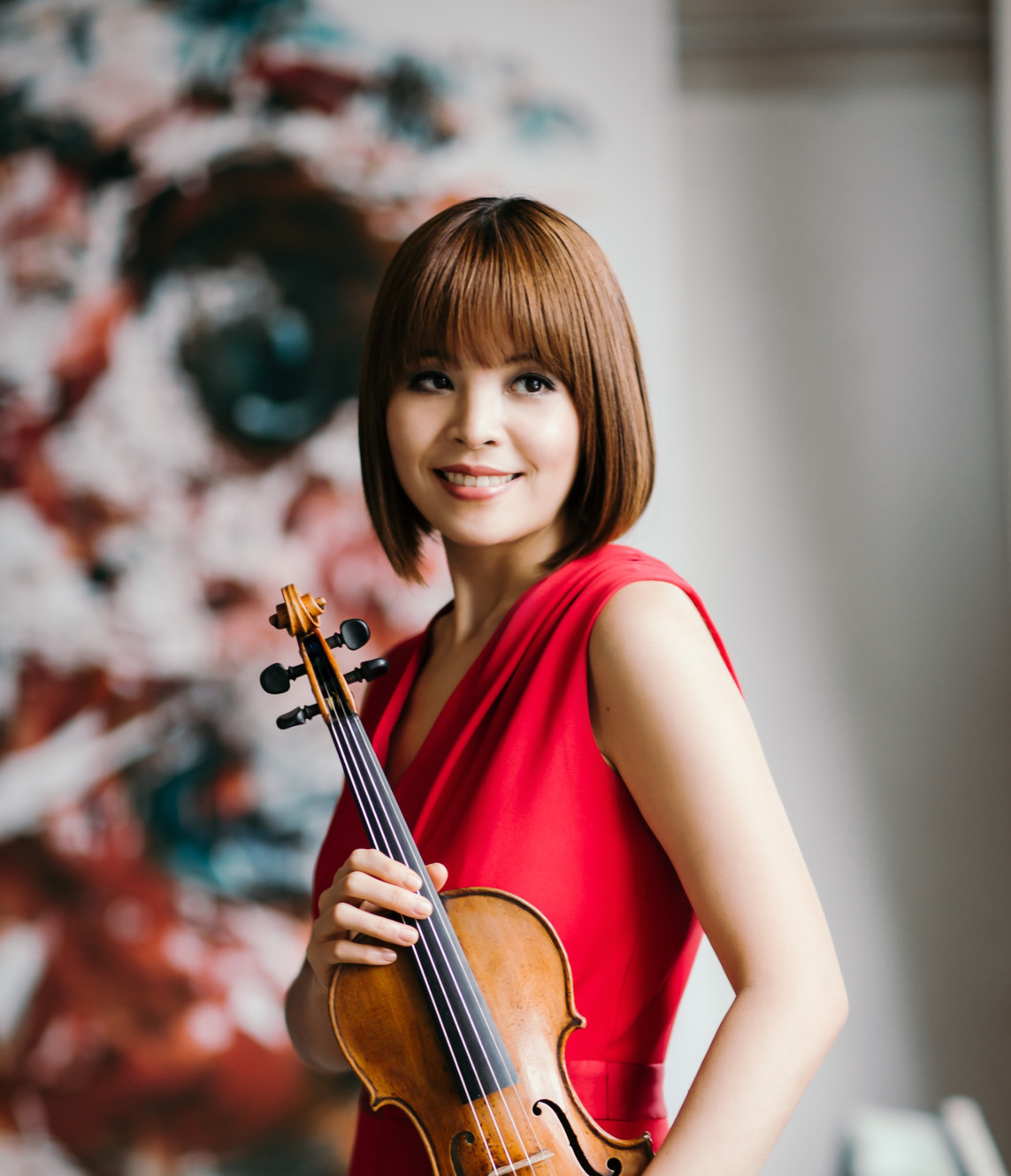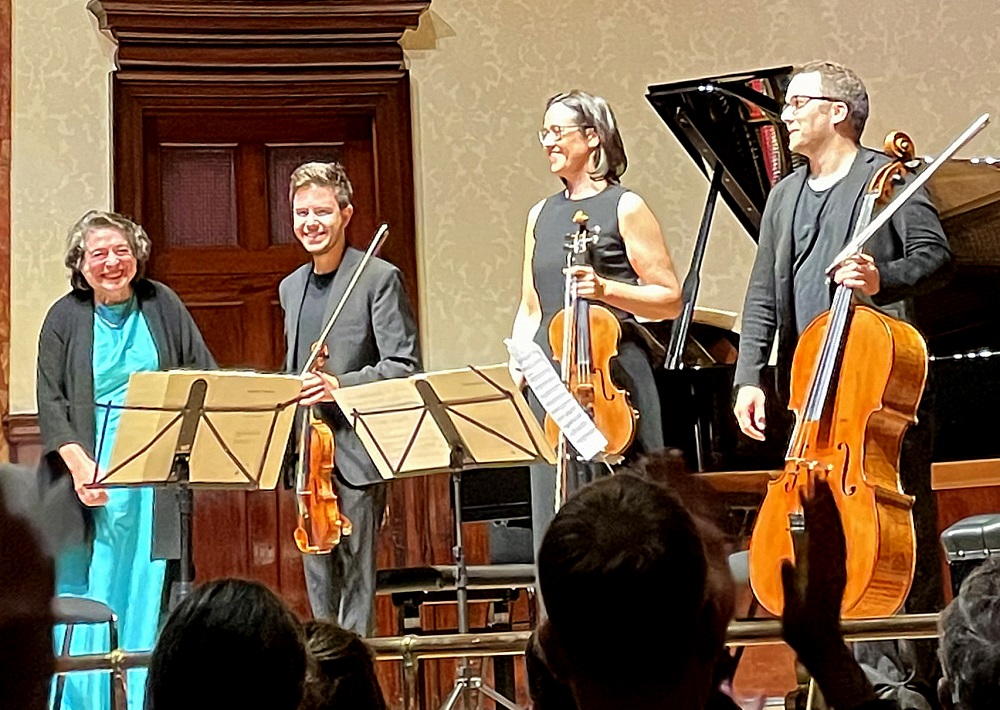Leonskaja, Staatskapelle Streichquartett, Wigmore Hall review - Brahms the chameleon | reviews, news & interviews
Leonskaja, Staatskapelle Streichquartett, Wigmore Hall review - Brahms the chameleon
Leonskaja, Staatskapelle Streichquartett, Wigmore Hall review - Brahms the chameleon
Every quick-change nuance in the first two Piano Quartets transcendentally realised

Epic-lyric magician Brahms wears a very adaptable garment for certain masterpieces: black on the outside with fur trimming, reversible to show its exquisitely wrought, variegated silk patterns on the inside.
For the celebrated G minor Piano Quartet and the First Piano Concerto – which Elisabeth Leonskaja has featured so impressively in concert with its successor – the darkness predominates, but the colours flash too. In the Second Concerto and Quartet, the bright reverse takes the lead. There can surely be no team more adaptable to all the miracles than Leonskaja and members of the Staatskapelle String Quartet of Berlin.
 These are players from Barenboim’s Berlin opera orchestra, and lined up for chamber music with the (equal) best at his suggestion. Konzertmeister(in) Jiyoon Lee (pictured right by Zuzanna Specjal) joined three of the original quartet, taking Wolfgang Brandl’s place in the A major Quartet. The tone is as radiantly beautiful as any violinist’s I’ve heard, a match for the darker singing voices of viola player Yulia Deyneka and cellist Claudius Popp. Kryysztof Specjal led the G minor in the second half, slimmer soundwise but unsurprisingly fine-tuned to his regular colleagues. It was inevitable, perhaps, that the dazzling “gypsy rondo” of No. 1 should bring down the curtain, and the house, but I’d have preferred No. 2 to appear in order, since it’s the richer work.
These are players from Barenboim’s Berlin opera orchestra, and lined up for chamber music with the (equal) best at his suggestion. Konzertmeister(in) Jiyoon Lee (pictured right by Zuzanna Specjal) joined three of the original quartet, taking Wolfgang Brandl’s place in the A major Quartet. The tone is as radiantly beautiful as any violinist’s I’ve heard, a match for the darker singing voices of viola player Yulia Deyneka and cellist Claudius Popp. Kryysztof Specjal led the G minor in the second half, slimmer soundwise but unsurprisingly fine-tuned to his regular colleagues. It was inevitable, perhaps, that the dazzling “gypsy rondo” of No. 1 should bring down the curtain, and the house, but I’d have preferred No. 2 to appear in order, since it’s the richer work.
Although these first two piano quartets were composed in the same year, 1861, and accumulate reams of thematic inspiration fit for a dozen such works, the second seems way ahead in terms of fluidity, surprises and dialogues between pianist and the three string players. The flow seems like a spontaneous act in the first-movement exposition, its repeat doubly welcome with a softer grain from Leonskaja on the return of the opening calm. In the slow movements of both quartets, Brahms and the performers hit the emotional nail on the head with the very first phrase – does any other composer manage this in the same way? – before launching surprises on us: the victory march of No. 1’s Andante con moto, wittily sprung by Leonskaja before putting on its full military garb, the mystery arpeggios of No. 2 which get so magical a final answer at the end of the Poco adagio.
 Sleight of hand is Brahms’s prerogative, but it takes a chamber ensemble of this supreme sophistication to make it sound so fresh and new: the sudden cut-offs, the serious innards of the otherwise urbane Second Quartet finale, the hilarious quick changes of the First’s tziganery; though the players kept straight faces for this, the humour was all there, the final flash brilliant almost beyond belief. Above all, though she never dominates, Leonskaja (pictured above by Charlotte Connal at the end of the concert with Specjal, Deyneka and Popp) has to be Brahms's best earthly representative right now, moving from absolute clarity of thunder to supreme delicacy. I can hardly wait for the third instalment of the trilogy and the Piano Quintet in January.
Sleight of hand is Brahms’s prerogative, but it takes a chamber ensemble of this supreme sophistication to make it sound so fresh and new: the sudden cut-offs, the serious innards of the otherwise urbane Second Quartet finale, the hilarious quick changes of the First’s tziganery; though the players kept straight faces for this, the humour was all there, the final flash brilliant almost beyond belief. Above all, though she never dominates, Leonskaja (pictured above by Charlotte Connal at the end of the concert with Specjal, Deyneka and Popp) has to be Brahms's best earthly representative right now, moving from absolute clarity of thunder to supreme delicacy. I can hardly wait for the third instalment of the trilogy and the Piano Quintet in January.
- More Brahms from Leonskaja and the Staatskapelle String Quartet at the Wigmore Hall on 29 January 2023
- More classical reviews on theartsdesk
rating
Share this article
The future of Arts Journalism
You can stop theartsdesk.com closing!
We urgently need financing to survive. Our fundraising drive has thus far raised £49,000 but we need to reach £100,000 or we will be forced to close. Please contribute here: https://gofund.me/c3f6033d
And if you can forward this information to anyone who might assist, we’d be grateful.

Subscribe to theartsdesk.com
Thank you for continuing to read our work on theartsdesk.com. For unlimited access to every article in its entirety, including our archive of more than 15,000 pieces, we're asking for £5 per month or £40 per year. We feel it's a very good deal, and hope you do too.
To take a subscription now simply click here.
And if you're looking for that extra gift for a friend or family member, why not treat them to a theartsdesk.com gift subscription?
more Classical music
 Hallé John Adams festival, Bridgewater Hall / RNCM, Manchester review - standing ovations for today's music
From 1980 to 2025 with the West Coast’s pied piper and his eager following
Hallé John Adams festival, Bridgewater Hall / RNCM, Manchester review - standing ovations for today's music
From 1980 to 2025 with the West Coast’s pied piper and his eager following
 Kaploukhii, Greenwich Chamber Orchestra, Cutts, St James's Piccadilly review - promising young pianist
A robust and assertive Beethoven concerto suggests a player to follow
Kaploukhii, Greenwich Chamber Orchestra, Cutts, St James's Piccadilly review - promising young pianist
A robust and assertive Beethoven concerto suggests a player to follow
 Robin Holloway: Music's Odyssey review - lessons in composition
Broad and idiosyncratic survey of classical music is insightful but slightly indigestible
Robin Holloway: Music's Odyssey review - lessons in composition
Broad and idiosyncratic survey of classical music is insightful but slightly indigestible
 Classical CDs: Wolf-pelts, clowns and social realism
British ballet scores, 19th century cello works and contemporary piano etudes
Classical CDs: Wolf-pelts, clowns and social realism
British ballet scores, 19th century cello works and contemporary piano etudes
 Bizet in 150th anniversary year: rich and rare French offerings from Palazzetto Bru Zane
Specialists in French romantic music unveil a treasure trove both live and on disc
Bizet in 150th anniversary year: rich and rare French offerings from Palazzetto Bru Zane
Specialists in French romantic music unveil a treasure trove both live and on disc
 Scottish Chamber Orchestra, Ibragimova, Queen’s Hall, Edinburgh review - rarities, novelties and drumrolls
A pity the SCO didn't pick a better showcase for a shining guest artist
Scottish Chamber Orchestra, Ibragimova, Queen’s Hall, Edinburgh review - rarities, novelties and drumrolls
A pity the SCO didn't pick a better showcase for a shining guest artist
 Kilsby, Parkes, Sinfonia of London, Wilson, Barbican review - string things zing and sing in expert hands
British masterpieces for strings plus other-worldly tenor and horn - and a muscular rarity
Kilsby, Parkes, Sinfonia of London, Wilson, Barbican review - string things zing and sing in expert hands
British masterpieces for strings plus other-worldly tenor and horn - and a muscular rarity
 From Historical to Hip-Hop, Classically Black Music Festival, Kings Place review - a cluster of impressive stars for the future
From quasi-Mozartian elegance to the gritty humour of a kitchen inspection
From Historical to Hip-Hop, Classically Black Music Festival, Kings Place review - a cluster of impressive stars for the future
From quasi-Mozartian elegance to the gritty humour of a kitchen inspection
 Shibe, LSO, Adès, Barbican review - gaudy and glorious new music alongside serene Sibelius
Adès’s passion makes persuasive case for the music he loves, both new and old
Shibe, LSO, Adès, Barbican review - gaudy and glorious new music alongside serene Sibelius
Adès’s passion makes persuasive case for the music he loves, both new and old
 Anja Mittermüller, Richard Fu, Wigmore Hall review - a glorious hall debut
The Austrian mezzo shines - at the age of 22
Anja Mittermüller, Richard Fu, Wigmore Hall review - a glorious hall debut
The Austrian mezzo shines - at the age of 22
 First Person: clarinettist Oliver Pashley on the new horizons of The Hermes Experiment's latest album
Compositions by members of this unusual quartet feature for the first time
First Person: clarinettist Oliver Pashley on the new horizons of The Hermes Experiment's latest album
Compositions by members of this unusual quartet feature for the first time

Add comment